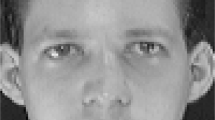Abstract
In this paper, we present a novel 3D face recognition algorithm based on the sparse representation. First, a 3D face normalization approach is proposed to deal with the raw faces. Then, three types of facial geometrical features are extracted to describe the 3D faces. Meanwhile, in order to guarantee the feasibility of the sparse representation framework and promote the recognition efficiency, a novel feature ranking scheme based on Fisher linear discriminant analysis (FLDA) is designed to arrange the facial descriptors. Finally, the sparse representation framework is used to collect all the face features, and it addresses the recognition task. The experiments tested on the BJUT-3D and FRGC v2.0 databases demonstrate the validity of the proposed 3D face recognition algorithm, and the necessity of the FLDA ranking scheme in the sparse representation framework.
Similar content being viewed by others
References
Zhao W, Chellappa R, Rosenfeld A (2003) Face recognition: a literature survey. ACM Comput Surv 35:399–458
Bowyer K, Chang K, Flynn P (2006) A survey of approaches and challenges in 3d and multi-modal 3d + 2d face recognition. Comput Vis Image Underst 101(1):1–15
Chang KI, Bowyer KW, Flynn PJ (2005) Adaptive rigid multi-region selection for handling expression variation in 3d face recognition. In: IEEE workshop on computer vision and pattern recognition
Samir C, Arivastava A, Daoudi M (2006) Three-dimensional face recognition using shapes of facial curves. IEEE Trans Pattern Anal Mach Intell 28(11):1858–1863
Gupta S, Markey MK, Bovik AC (2007) Advances and challenges in 3d and 2d + 3d human face recognition. Nova Science Publishers, New York
Mian AS, Bennamoun M, Owens RA (2007) An efficient multimodal 2d − 3d hybrid approach to automatic face recognition. IEEE Trans Pattern Anal Mach Intell 29(11):1927–1943
Mpiperis I, Malassiotis S, Strintzis MG (2008) Bilinear models for 3-d face and facial expression recognition. IEEE Trans Inform Forens Secur 3(3):498–511
Mahoor MH, Abdel-Mottaleb M (2009) Face recognition based on 3d ridge images obtained from range data. Pattern Recogn 42(3):445–451
Li X, Jia T, Zhang H (2009) Expression-insensitive 3d face recognition using sparse representation. In: Proc of computer vision and pattern recognition, pp 2575–2582
Tsalakanidou F, Malassiotis S (2010) Real-time 2d + 3d facial action and expression recognition. Pattern Recogn 43(5):1763–1775
Candes E, Romberg J, Tao T (2006) Robust uncertainty principles: exact signal reconstruction from highly incomplete frequency information. IEEE Trans Inform Theory 52(2):489–509
Donoho D (2006) Compressed sensing. IEEE Trans Inform Theory 52(4):1289–1306
Wright J, Yang A, Ganesh A, Sastry S, Ma Y (2009) Robust face recognition via sparse representation. IEEE Trans Pattern Anal Mach Intell 31(2):210–227
Belhumeur PN, Hespanha JP, Kriegman DJ (1997) Eigenfaces vs. fisherfaces: recognition using class specific linear projection. IEEE Trans Pattern Anal Mach Intell 19(7):711–720
BJUT-3D Face Database (2005) http://www.bjpu.edu.cn/sci/multimedia/mul-lab/3dface/facedatabase.htm
Phillips PJ, Flynn PJ, Scruggs T et al (2005) Overview of the face recognition grand challenge. In: Proc of computer vision and pattern recognition
Gu CL, Yin BC, Hu YL, Cheng SQ (2004) Resampling based method for pixel-wise correspondence between 3d faces. In: Proc of information technology: coding and computing, vol 1, pp 614–619
Sun YF, Tang HL, Yin BC (2008) The 3d face recognition algorithm fusing multi-geometry features. In: Acta automatica sinica, vol 34(12), pp 1483–1489
Kazarinoff MD (1961) Geometric inequalities, new math. Library, Math Assoc of America
Author information
Authors and Affiliations
Corresponding author
Rights and permissions
About this article
Cite this article
Tang, H., Sun, Y., Yin, B. et al. 3D face recognition based on sparse representation. J Supercomput 58, 84–95 (2011). https://doi.org/10.1007/s11227-010-0533-9
Published:
Issue Date:
DOI: https://doi.org/10.1007/s11227-010-0533-9




